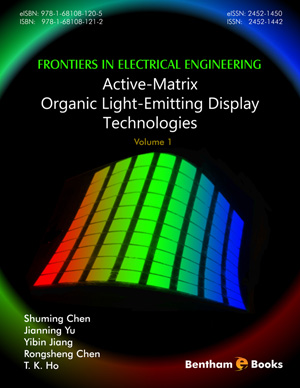Introduction to Organic Light-Emitting Display Technologies
Page: 3-39 (37)
Author: Shuming Chen and Jianning Yu
DOI: 10.2174/9781681081205115010003
PDF Price: $15
Abstract
Organic Light Emitting Diodes (OLEDs) emerged 30 years ago as a very promising flat-panel display technology because of their lots of advantages. OLEDs consist of several nanometer-scale thin films between anode and cathode, which can be integrated on various substrates, especially the ultra-thin and flexible substrates. As a result, OLEDs present advantages of high efficiency, lightweight, fast response time, wide viewing angle, vivid color, high contrast and etc. After development of technology improvement over past several decades, enormous progress has been made to promote OLED products to be launched into market. In this chapter, we review the development history of OLEDs, with special emphasis on several key technical innovations which significantly advanced the industrialization. From two main application filed of display and lighting, we describe the working mechanism, technical development, advantages and disadvantages, and production status of OLED technology.
White Organic Light-Emitting Diodes for Display and Lighting Application
Page: 40-61 (22)
Author: Shuming Chen
DOI: 10.2174/9781681081205115010004
PDF Price: $15
Abstract
The history of white light organic light-emitting diodes (WOLEDs) can be dated back to 1993 when Kido and coworkers reported the first OLEDs that emit white color, i.e., the emitted light contain wavelengths across the entire visible spectrum [1, 2]. From then on, considerable research efforts have been devoted throughout the world by both academia and industry in developing efficient WOLEDs for next generation high resolution large area displays and solid-state light sources. In this chapter, the applications of WOLEDs in display and lighting will first be presented, followed by introducing the general approaches to achieve white light emission. Finally, challenges and solutions for large area, high efficiency and high CRI WOLEDs will be posed.
Light Outcoupling Technologies
Page: 62-88 (27)
Author: Yibin Jiang and Shuming Chen
DOI: 10.2174/9781681081205115010005
PDF Price: $15
Abstract
This chapter gives comprehensive description of the light outcoupling technologies for organic light-emitting diodes (OLEDs). Some state of art techniques will be introduced in detail. This chapter consists of three parts. The first part analyzes the light distribution in OLED with two models: ray optics model and dipole interference model. The second part introduces the external extraction structures, which can extract the light trapped in the substrate. The last part describes the more effective outcoupling technologies, the internal extraction structures, which can couple out not only the light in the substrate but also the light trapped in the active layers of the device. Finally, a conclusion will be given.
Encapsulation Technologies
Page: 89-111 (23)
Author: Yibin Jiang and Shuming Chen
DOI: 10.2174/9781681081205115010006
PDF Price: $15
Abstract
Flexible organic light emitting diode (OLED) display is an exciting and attractive technology to the consumers and the manufacturers, but there still exists a few challenges before it comes into real application. The biggest challenge is the demanding water and oxygen permeation requirement of the encapsulation, since the lifetime of OLED will drastically decrease when it is exposed to moisture and oxygen. As the barrier performance of polymer is not as good as that of glass, both sides of the OLED device which is deposited on polymer substrate need to be encapsulated by dense thin films. This chapter will provide a summary of the encapsulation technologies, including the traditional encapsulation and the advanced thin film encapsulation. First, the degradation mechanism, the permeation mechanism, and the permeation measurement are introduced as background information. Then thin film encapsulation technologies (Vitex organic/inorganic multilayer and atomic layer deposited film) will be the main topic.
Thin Film Transistor Technology
Page: 112-160 (49)
Author: Rongsheng Chen
DOI: 10.2174/9781681081205115010007
PDF Price: $15
Abstract
TFTs with large field-effect mobility, low threshold voltage, sharp subthreshold swing, small leakage current, good uniformity, high stability and reliability are highly desired for high resolution active matrix OLED application. The three most popular technologies for the TFT backplane are a-Si TFT technology, LTPS technology and metal oxide TFT technology. There also exist some promising compounds TFTs, such as GaN, MoS2 TFTs, and so on. The main properties of these technologies will be introduced and studied in this chapter.
Driving Schemes and Design Considerations for AMOLED
Page: 161-201 (41)
Author: Tsz Kin Ho
DOI: 10.2174/9781681081205115010008
PDF Price: $15
Abstract
State of the art thin-film transistor technologies continue to fuel new areas of researches and applications in flat-panel display. However, this does not come without new issues related to device-circuit stability and uniformity over large areas, placing an even greater need for new backplane designs, driving algorithms and compensation techniques in pixel architectures. In this work, we explained design considerations for active matrix backplane. We outline a systematic design approach, including circuit theory, enabling user to design circuits without worrying about the details of device physics.
Introduction
Frontiers in Electrical Engineering is a book series dedicated to publishing current research in the field of electrical engineering and electronics. The vast amount of publications concerning these fields are summarized in each series volumes with a key focus on device structures and fabrication techniques that are pertinent to the practical production processes and electronic applications. This volume presents an introduction to the subject of Active-Matrix Organic Light-Emitting Display (AMOLED) technology. AMOLEDs are generally integrated into electronic applications and production processes, including understanding basic optical LED (OLED) working principles and the fabrication and characterization of electronic and semiconductor devices. Other applications of AMOLEDs include white OLEDs, light outcoupling, encapsulation, thin film transistor backplanes, driving schemes, and circuit and layout design technologies. This volume will be helpful to novice scientists and engineers working on the development of practical OLED display and OLED lighting technology. Researchers studying organic electronics and advanced undergraduate and graduate students and professionals involved in the OLED industry will also benefit from the information given in this monograph.





















